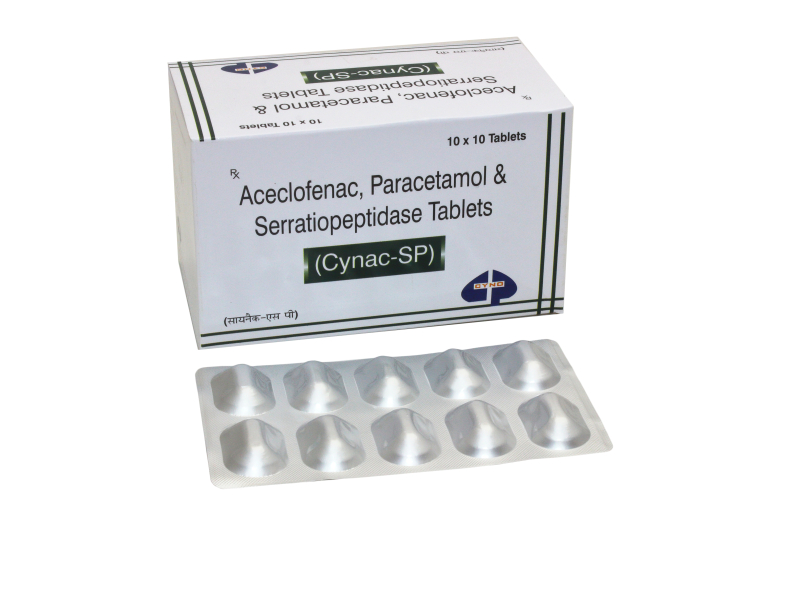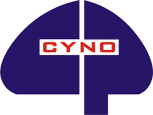CYNAC - SP
Aceclofenac (100 mg), Paracetamol (325 mg), Serratiopeptidase (10 mg)
Aceclofenac is a non-steroidal anti-inflammatory drug (NSAID) analog of Diclofenac. It is used to relieve pain and inflammation in rheumatoid arthritis, osteoarthritis, and ankylosing spondylitis. The dose is 100 mg twice daily.
It should not be given to people with porphyria or breast-feeding mothers and is not recommended for children.

Mechanism Of Action:
Aceclofenac has a higher anti-inflammatory action than conventional NSAIDs. It is a cytokine inhibitor. Aceclofenac works by inhibiting the action of any substance in the body called cyclo-oxygenase. Cyclo-oxygenase is involved in the production of prostaglandins (chemicals in the body) that cause pain, swelling, and inflammation. Aceclofenac is the glycolic acid ester of diclofenac.
Paracetamol:
Acetanilide derivative, Non narcotic Analgesic,Antipyretic.
Paracetamol has analgesic and antipyretic action.
It is more active on the cyclo-oxygenase enzyme in the brain. Seriously it is a poor inhibitor of prostaglandin synthesis.
Analgesic action: Paracetamol increases the pain threshold and produces analgesic effects.
Antipyretic action: Paracetamol reduces fever and inhibits the effects of endogenous pyrogens by direct action at the thermoregulatory center in the hypothalamus.
Serratiopeptidase
A proteolytic enzyme, A powerful anti-inflammatory, anti-endemic.
This anti-inflammatory proteolytic enzyme binds to alpha-2-macroglobulin in the blood, which helps mask its antigenicity. It is then slowly transferred to the site of inflammation. Serratiopeptidase hydrolyzes bradykinin, histamine, serotonin responsible for edema. It reduces inflammation, improves microcirculation and expulsion of sputum. Due to this action, serratiopeptidase has anti-inflammatory, antilipidemic, and fibrinolytic activity and acts rapidly on local inflammation.
Half-Life of Aceclofenac:
The mean plasma elimination half-life is 4 – 4.3 hours
Indications for Aceclofenac:
1. Ankylosing spondylitis
2. Osteoarthritis
3. Symptomatic treatment of pain and inflammation in Post-Traumatic pain
4. Cervical pain
5. Low back pain
6. Acute gout
The onset of Action for Paracetamol:
30 – 60 minutes
Half-Life of Paracetamol:
1-4 hour
Indications for Paracetamol:
1. To relieve pain and fever
2. Acute gout
3. Migrain
Indications for Serratiopeptidase:
1. Antiinflammatory
2. Antiswelling
3. Anti- rheumatoid
4. To promote the transfer of antibiotics to the site of action
5. To promote lysis and discharge of sputum and pus
6. Bronchitis
7. Fibrocystic breast swelling
8. Sinusitis
9. Cough
10. Laryngitis
11. Fibromyalgia
12. Emphysema
13. Gout
Pharmacokinetic Properties:
Pharmacokinetics of Aceclofenac:
Absorption – It is rapidly and completely absorbed after oral administration.
Distribution- Widely distributed in the body in protein-form. It is highly protein-bound (> 99.7%). Aceclofenac penetrates the synovial fluid, where concentrations reach about 60% in the plasma.
Metabolism- Metabolites in the liver cause metabolism. The main metabolite is 4-hydroxycyclofenac.
Excretion – It is mainly excreted through urine.
Pharmacokinetics of Paracetamol:
Absorption: Paracetamol is rapidly and completely absorbed after oral administration.
Distribution: It is mostly distributed in the unbound form in the body.
Metabolism: It is extensively metabolized in the liver.
Excretion: Excreted in the urine.
Pharmacokinetics of Serratiopeptidase:
Orally absorbed. In the case of bowel coated tablets, there is absorption in the intestine. After absorption, it enters the bloodstream directly. It is excreted through urine and bile.
Drug-Drug interactions:
Interactions for Aceclofenac:
Lithium, digoxin, and methotrexate: Aceclofenac may increase plasma concentrations of lithium, digoxin, and methotrexate.
Anticoagulants: The activity of anticoagulants may increase.
Diuretics: Aceclofenac inhibits the activity of diuretics. When potassium is administered concomitantly with sparing diuretics, serum potassium should be monitored.
Cyclosporine: Aceclofenac cyclosporine may increase nephrotoxicity.
Quinolones: Aceclofenac can exacerbate spasms when coadministered with quinolone antibiotics.
Precautions:
Special Precautions while taking Serratiopeptidase:
In patients with renal failure or hepatic failure
Special Precautions while taking Aceclofenac:
Hepatic porphyria, Bleeding tendencies, Blood disorders, Crohn`s disease, Decreased heart function, History of peptic ulcers, Inflammation of the bowel and back passage, Mildly decreased kidney function, Recent major surgery, Stomach disorders, Decreased liver function, Intestinal disorders
Special Precautions while taking Paracetamol:
Hepatic impairment, Renal impairment, Hypertension
Breastfeeding: Contraindicated/Use with caution
Fertility:
The use of Aceclofenac can impair female fertility and is not recommended in women who try to conceive. Women who have difficulties in conceiving or who are undergoing infertility testing should take Aceclofenac 100 mg film-coated tablets.
Dosage:
Typical Dosage for Paracetamol:
Adult:
500 – 1000 mg in 3 times daily
Maximum dose: 4 g / day
For migraine: 500 mg to be taken at the first sign of migraine attack and repeated 4 – 6 hourly until suppress mild attacks.
Children:
60 mg / kg body weight /day in 4 divided doses.
Duration of action:
Duration of Action for Serratiopeptidase:
8 to 10 hrs
Duration of Action for Paracetamol:
6 hours
Adverse Reaction:
Skin reaction, Muscle and joint pain, Poor appetite, Nausea, Stomach pain
cough, Blood clotting disturbances
Storage:
Store at room temperature (10-30°C)
Overdosage:
Management of acute toxicity with NSAIDs essentially involves supportive and symptomatic measures.
a) symptoms
Symptoms include headache, nausea, vomiting, epigastric pain, gastrointestinal irritation, gastrointestinal bleeding, rarely diarrhea, disorientation, excitement, coma, drowsiness, dizziness, tinnitus, hypotension, respiratory depression, fainting, occasional convulsions. . Acute renal failure and liver damage are possible in cases of significant toxicity.
B) therapeutic measures
Patients should be treated as needed.
Within an hour of ingestion of a potentially toxic amount, activated charcoal should be considered. Alternatively, in adults, gastric lavage should be considered within one hour of ingestion of a potentially life-threatening overdose.
Contraindications:
Contra-indications of Aceclofenac:
1. Hypersensitivity to the drug
2. Bleeding from the stomach or intestines
3. Moderate to severely decreased kidney function
4. Hypersensitivity to other NSAIDs
5. Active peptic ulcer
Contra-indications of Paracetamol:
Hypersensitivity to Paracetamol
Contra-indications of Serratiopeptidase:
1. Hypersensitivity to this drug
2. Blood coagulation disorder
Side Effects of Aceclofenac:
1. Dyspepsia
2. Abdominal pain
3. Dizziness
4. Vertigo
5. Pruritis
6. Rash
7. Dermatitis
8. Nausea
9. Diarrhoea
10. Flatulence
11. Gastritis
12. Constipation
13. Vomiting
14. Ulcerative stomatitis
15. Elevation of circulating levels of hepatic enzymes.
Side Effects of Paracetamol:
1. Nausea
2. Abdominal distress
3. Allergic reactions
4. Rash
Side Effects of Serratiopeptidase:
1. Hypersensitivity
2. Anorexia
3. Gastric discomfort
4. Nausea
5. Vomiting
6. Epistaxis
7. Diarrhoea
8. Skin rash
Warnings:
This medicine should be used with caution in the elderly due to the increased risk of serious adverse effects. Treatment with this medicine should be started at low doses to check for tolerance. Depending on the clinical condition, close monitoring of renal and liver function may be necessary for such patients.
This medicine is not recommended for use in patients under 18 years of age as the safety and efficacy of the use are not clinically established.
Pregnancy: Contraindicated/ Use with caution
Children Related Information: Use with caution
